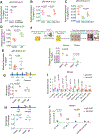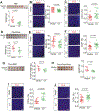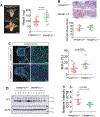Androgen-regulated stromal complement component 7 (C7) suppresses prostate cancer growth
- PMID: 37400528
- PMCID: PMC10802183
- DOI: 10.1038/s41388-023-02759-7
Androgen-regulated stromal complement component 7 (C7) suppresses prostate cancer growth
Abstract
The complement system is a major component of the innate immune system that works through the cytolytic effect of the membrane attack complex (MAC). Complement component 7 (C7) is essential for MAC assembly and its precisely regulated expression level is crucial for the cytolytic activity of MAC. We show that C7 is specifically expressed by the stromal cells in both mouse and human prostates. The expression level of C7 inversely correlates with clinical outcomes in prostate cancer. C7 is positively regulated by androgen signaling in the mouse prostate stromal cells. The androgen receptor directly transcriptionally regulates the mouse and human C7. Increasing C7 expression in the C57Bl/6 syngeneic RM-1 and Pten-Kras allografts suppresses tumor growth in vivo. Conversely, C7 haploinsufficiency promotes tumor growth in the transgenic adenocarcinoma of the mouse prostate (TRAMP) model. Interestingly, replenishing C7 in androgen-sensitive Pten-Kras tumors during androgen depletion only slightly enhances cellular apoptosis, highlighting the diverse mechanisms employed by tumors to counteract complement activity. Collectively, our research indicates that augmenting complement activity could be a promising therapeutic approach to impede the development of castration resistance in prostate cancer.
© 2023. The Author(s), under exclusive licence to Springer Nature Limited.
Conflict of interest statement
COMPETING INTERESTS
The authors declare no competing interests.
Figures






Similar articles
-
Gli Transcription Factors Mediate the Oncogenic Transformation of Prostate Basal Cells Induced by a Kras-Androgen Receptor Axis.J Biol Chem. 2016 Dec 2;291(49):25749-25760. doi: 10.1074/jbc.M116.753129. Epub 2016 Oct 19. J Biol Chem. 2016. PMID: 27760825 Free PMC article.
-
Id4 deficiency attenuates prostate development and promotes PIN-like lesions by regulating androgen receptor activity and expression of NKX3.1 and PTEN.Mol Cancer. 2013 Jun 21;12:67. doi: 10.1186/1476-4598-12-67. Mol Cancer. 2013. PMID: 23786676 Free PMC article.
-
Broadening of transgenic adenocarcinoma of the mouse prostate (TRAMP) model to represent late stage androgen depletion independent cancer.Prostate. 2008 Apr 1;68(5):548-62. doi: 10.1002/pros.20714. Prostate. 2008. PMID: 18247402
-
Stromal androgen receptor in prostate development and cancer.Am J Pathol. 2014 Oct;184(10):2598-607. doi: 10.1016/j.ajpath.2014.06.022. Epub 2014 Aug 1. Am J Pathol. 2014. PMID: 25088980 Free PMC article. Review.
-
Experimental evidence of persistent androgen-receptor-dependency in castration-resistant prostate cancer.Int J Mol Sci. 2013 Jul 26;14(8):15615-35. doi: 10.3390/ijms140815615. Int J Mol Sci. 2013. PMID: 23896594 Free PMC article. Review.
Cited by
-
Complement activity and autophagy are dysregulated in the lungs of patients with nonresolvable COVID-19 requiring lung transplantation.Respir Res. 2025 Feb 27;26(1):68. doi: 10.1186/s12931-025-03152-6. Respir Res. 2025. PMID: 40016722 Free PMC article.
-
Multiomics Analysis of Disulfidptosis Patterns and Integrated Machine Learning to Predict Immunotherapy Response in Lung Adenocarcinoma.Curr Med Chem. 2024;31(25):4034-4055. doi: 10.2174/0109298673313281240425050032. Curr Med Chem. 2024. PMID: 38685772
-
Distinct mesenchymal cell states mediate prostate cancer progression.Nat Commun. 2024 Jan 8;15(1):363. doi: 10.1038/s41467-023-44210-1. Nat Commun. 2024. PMID: 38191471 Free PMC article.
-
Immune cells mediate the causal pathway linking circulating complements to cancer: A Mendelian randomization study.Inflamm Res. 2024 Dec;73(12):2141-2152. doi: 10.1007/s00011-024-01955-9. Epub 2024 Oct 1. Inflamm Res. 2024. PMID: 39352488
References
-
- Rutkowski MJ, Sughrue ME, Kane AJ, Mills SA, Parsa AT. Cancer and the complement cascade. Mol Cancer Res 2010;8:1453–65. - PubMed
Publication types
MeSH terms
Substances
Grants and funding
LinkOut - more resources
Full Text Sources
Medical
Molecular Biology Databases
Research Materials
Miscellaneous

